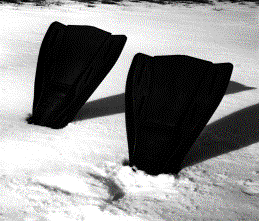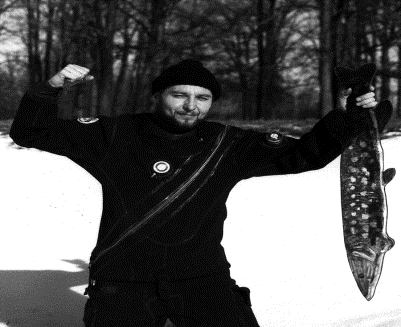
by
Larry "Harris" Taylor, Ph.D.
Photography by Mike Spears
This is an
electronic reprint of an article that appeared in SOURCES (Mar/Apr. 1991, p.
33-35). This material is copyrighted and all rights retained by the author. This
article is made available as a service to the diving community by the author
and may be distributed for any non-commercial or Not-For-Profit use.
All rights reserved.
Go To: Home About "Harris" Articles Slides War Stories Editorials Links Fini
Ann Arbor was buried in the greatest snowstorm in recorded
history. The frigid air and immense snowfall had reduced the city to a
standstill. The snow was so high that even the ivory towered pinnacles of the
University of Michigan were hidden under its massive white blanket. The enormity
of this grave predicament was demonstrated by the cancellation of the Michigan -
Ohio State football game. Outside
my window, it was quiet ... like a scene from "The Shining." My thoughts were interrupted by the
ringing phone.
At first I was delighted to hear the effervescent voice of
Linda, my Hawaiian dive buddy. She talked of strolling on a sandy white beach
and of diving with the humpback whales on a day that was a mere 150 F warmer
than Ann Arbor's current -78 F wind chill factor. She relayed to me her delight
in winning the recent Hawaiian Islands spear fishing contest. Slowly, I realized
that I was talking to a very "machette" (fem. of macho) lady. Here was a woman
who was not only playing at the male dominated sport of spear fishing, but was
beating everyone at their game; her victories were by no small margin. Here was
a woman who was surviving by her physical prowess as a huntress, while I, a
snowbound wimp academic had never hunted anything other than the freshwater
crayfish of Grand Traverse Bay. (Crayfish are tasty, but not exactly a
formidable opponent.) As I listened to her exploits, my pride as a man
diminished. (It has only recently been scientifically proven that the male ego
is, indeed, the most fragile substance in the universe; something women have
known for centuries.) In a Don Quixote type manner, my mind began to wander as I
contemplated exploits that would impress even my huntress friend. After hanging
up the phone, I retreated to the quiet womb of my library.
There, in an obscure text, LEGENDARY FISHES OF THE GREAT
LAKES, I read the legend of the elusive Great Snow Pike. Surely, no greater trophy existed. I
decided that I would hunt and capture this most magnificent of creatures. Unfortunately, I knew nothing about
hunting or my intended prey. Learning the hunting part was easy. Some scuba
training agencies offer diving specialty training without the absurd necessity
of getting into the water. So, I
listened to 30 minutes of lecture on the joys of being an underwater hunter.
Then, without ever using a spear gun or having to get my hands dirty capturing
and cleaning some underwater critter, I was a certified Underwater Hunter. I
then returned to my diving library in an attempt to learn more about my intended
quarry.
The Great Snow Pike (Esox Mythacus) is an exceedingly rare
member of the pike family. Like all other pikes, it has a long torpedo-like
body. It is carnivorous. The adult
male is generally over 3 feet in length.
It has been hypothesized that in the larger, more northern snowfields the
fish may grow to lengths exceeding 10 feet. The fish (photo 1) appears as a
large, but exceptionally thin, translucent Northern Pike. The most unusual feature of this critter
is its large red eye. Some authorities consider this to be infrared
sensitive. It is believed that it
stalks its prey by this heat-sensing organ. Like a shark, it also has long
lateral line vibration sensors, which may also play a role in tracking potential
prey. In the continental United States, the fish spends most of its life in
hibernation. Then, like the May fly, it emerges for a very short lifespan. Estimates range from one to seven days,
but data are scarce. The Great Snow
Pike lives in the snow and apparently only emerges during a crippling snowstorm.
(Reportedly, the snowplow is the Snow Pike's chief predator.)

Photo 1. Snow
Pike In Natural Habitat
The single most difficult aspect of Snow Pike hunting was
ignoring my friends and neighbors as I prepared for the hunt. The technique was
simple. First, the hunting site was
picked. I found a large open
snowfield at the base of a hill used by the locals for sledding. (In the snow, a child on a sled appears
like a Snow Sea Lion, the Snow Pike's favorite food.) This pelagic type
environment allows the Snow Pike freedom to move and hunt. Once the site was selected, we dug a
coffin-sized hole in the snow.
Then, wearing scuba gear, I lay on my back and had my dive buddy cover me
with snow. Note that this is an
overhead environment and double tanks, a Benjamin crossover, and redundant air
supply was necessary. Also, the
cold environment required adequate thermal protection. I used a dry suit with a
marine type b Thinsulate jumpsuit as insulation and a red Jacques Cousteau ski
hat. More financially secure divers may want to consider full-face mask with
hard-wire communication. I assumed (Photo 2) the preferred hunting position:
knees bent with a portion of the fins remaining above the surface of the
snow.

Photo 2.
Preferred "hunting posture"
Once buried, I slowly moved my fins back and forth. Here a
bicycle kick was preferred. The low frequency vibration of this technique
attracts the pike. (Much like a
thumper attracts the sand worms of the planet Arrakis.) It seemed like an
eternity, but as a patient and thermally protected Snow Pike hunter, I soon
heard what I thought was the sound of the Snow Pike. However, it would not
approach. (Later, I realized that
the sound I had heard was only the sound made my sled runners as they passed
near me.) I began to chill. I
looked around me. The world was
cold and all white. I knew that
soon I would be hallucinating as the altered state that comes from hypothermia
and sensory deprivation began to control me. The thought, however, of emerging
without my goal gave me strength. I
tried a different type of sound. I began to softly hum into my regulator. After about eight bars, I realized that
I was humming, "What Kind Of Fool Am I?"
At first, I thought it was an auditory hallucination ... a
soft swishing sound. Then I began to feel the power behind the sound. My heart
rate increased. Ignoring the danger from air embolism, I quit humming and held
my breath. My feet began to bicycle feverishly. I knew that the Snow Pike was
real and that IT was coming for me! I could not see it, but somehow, I sensed
its presence. With excruciating slowness I began to move my hands toward each
other. The Snow Pike slowly moved across my face towards my fins. I was
impressed by the grace of the beast. I made a grab for it. I somehow managed to
get a grip on the tail. The Pike exploded in a powerful burst of speed that
dragged me across the field. I held on. Eventually, it tired and I surfaced
holding on to my prized trophy ... a 3-foot Great Snow Pike (Photo
3).

Photo 3:
Author Displays Captured Snow Pike
Although reported to be good eating. (There are persistent
rumors that fish and chips served in Minnesota are in actuality Snow Pike.), I
could not bear to eat this once noble animal. So, I sought out a taxidermist. My
magnificent trophy is now on proud display. It hangs in a place of honor, just
above my Ph.D.
Even though I had captured a lesser member of the legendary
Great Snow Pike family, I still felt the immense macho pride of a hunter who has
bested one of Mother Nature's most feared predators. With ego ablaze I called
Linda to tell her of my exploits. I found that she was not at home in Hawaii,
but that she had gone home to Ohio to visit her parents.
This would be awesome! I would drive to Ohio and show her my
conquest. When I got to her parent's home, they were just sitting down for
dinner. They were eating a portion of the 10 foot Snow Muskellunge that Linda
had just caught!
Go To: Home About "Harris" Articles Slides War Stories Editorials Links Fini
About The
Author:
Larry "Harris" Taylor, Ph.D. is a biochemist and Diving Safety Coordinator at the University of Michigan. He has authored more than 200 scuba related articles. His personal dive library (See Alert Diver, Mar/Apr, 1997, p. 54) is considered one of the best recreational sources of information In North America
Article History:
This article was written at the request of Mike Williams, then editor of SOURCES. The request was for "serious" technical writers to attempt humor for an "April Fools" issue. Stalking the Great Snow Pike was my contribution to his request.
All rights reserved.
Use of these articles for personal or organizational profit is specifically denied.
These articles may be used for not-for-profit diving education